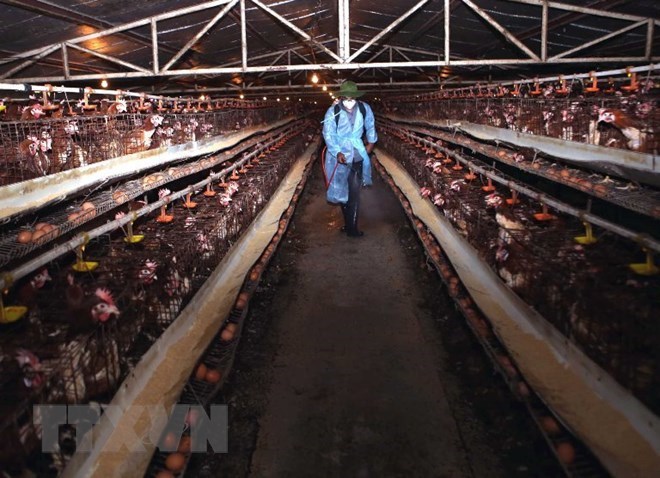Warning of possible new bird flu outbreaks in Vietnam
One hotbed of A/H5N6 bird flu virus had been reported recently in Dai Ban commune of An Duong district, northern Hai Phong city, the Department informed.
It noted some avian flu strains that haven’t been reported in Vietnam such as A/H7N9, A/H5N2 and A/H5N8 may enter the country through the transportation, trading and consumption of poultry and poultry products with obscure origin, especially in northern border provinces and the localities consuming smuggled poultry products.
The department urged localities to take the initiative in bird flu prevention, crack down on poultry smuggling, and keep a close watch on local situation in order to timely respond to any outbreak.
Meanwhile, foot-and-mouth and blue-ear diseases are also likely to break out among livestock that are unvaccinated or transported to former hotbeds.
 |
A veterinary worker fumigates a chicken farm (source: VNA)
The animal health agency called on vulnerable localities to augment monitoring, vaccination and control of livestock transportation and slaughtering to minimize risks of disease outbreak and spread.
Earlier, from January 17 to 19, bird flu was detected at a poultry-breeding farm in Diễn Châu District, the central province of Nghệ An.
Nearly 200 of the 800 poultry at the farm died, while the farm’s owner reported his poultry herd wasn’t vaccinated against bird flu.
The main route of transmission was smuggling of poultry and unknown-origin poultry products. Therefore, the Department of Animal Health asked local authorities to be active in prevention and controlling the threat of bird flu outbreaks, strengthen inspection and strictly tackle poultry smuggling and illegal transporting.
Local authorities and relevant departments should closely monitor the situation to ensure timely action against outbreaks.
Before Tet period, the Ministry of Health warned the disease could present a complicated challenge due to the spring weather, people’s over-use of food during and after Tết holidays and high travel demand. All these factors increase the risk of transmission.
Nguyễn Văn Kính, Director of the Central Tropical Disease Hospital, said the cold and humid weather was creating conditions for influenza viruses to develop.
According to health experts, the virus strain of A / H7N9 is one of the major threats in the world. Influenza A/H7N9 was recorded in 2013 in China but hasn’t been controlled yet.
In 2017, influenza A/H7N9 outbreak in China, including two border provinces with Việt Nam, with 100 deaths were reported.
The World Health Organization (WHO) and the United Nations Food and Agriculture Organization (FAO) have warned that the influenza A / H7N9 virus strain has changed from low to high virulence in both poultry and humans. It can kill 100 per cent of infected poultry and can transmit 100-1,000 times faster than a low virulence virus. People with this flu may develop edema, heart failure, severe liver failure, coma and death, according to two organizations./.
( VNF )
Most read
Recommended
 Handbook
Handbook
“Peach Blossom, Pho And Piano” To Be Shown During Vietnamese Film Week In Poland
 Handbook
Handbook
Film of Young Director Heads to 2024 Cannes Film Festival
 Handbook
Handbook
Vietnamese Dishes Honored Around The World
 Handbook
Handbook
Conductor Tran Nhat Minh Brings Vietnamese Folk Songs To The World
Popular article
 Handbook
Handbook
Vietnamese Student Wins Prizes At The Kyushu Music Concour International Music Competition
 Handbook
Handbook
Amanda Nguyen: The First Vietnamese Woman To Fly Into Space
 Handbook
Handbook
Three Vietnamese Ports Among Top 50 Largest Container Seaports Worldwide
 Handbook
Handbook








